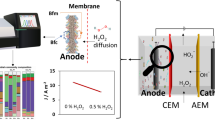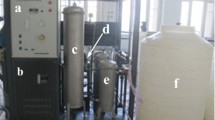Abstract
The supercritical concentration of CO2 (SCCO2) and a high concentration (3.0%) of molecules of hydrogen peroxide (H2O2) are currently being used as antiseptic and antibacterial agents. The fact that low concentrations of CO2 have an activation effect on functional activity of microbes allows us to predict that CO2 could elevate the toxic effect of H2O2 on cells. To check this hypothesis the dependency of the toxic effect of H2O2 on wild type of Escherichia coli K-12 on soluble concentration of CO2 in culture media was studied. The obtained data show that culture media enriched with CO2 leads to the increase of toxic effect of H2O2 on microbes at both cases when pH is constant and when it changes. So CO2 in non-supercritical concentration could elevate the toxic effect of H2O2 on microbes by the activation of the metabolic processes in microbes. During the experiments we used classical microbiological methods (indirect viable cell counts or counting colony forming units (CFUs)), as well as the method of measuring hydrogen peroxide content in aqueous solution by means of enhanced chemiluminescence method in a peroxidase-luminol-p-iodophenol system. This discovery is concerning to use CO2/H2O2 combination system, which could have implication in the inhibition of growth of microbes in water and the microbiological monitoring of water could provide valuable information for managing the health of exhibition of aqua ecosystems.






Similar content being viewed by others
References
Alaverdyan Z, Akopyan L, Charyan L, Airapetyan S (1996) Impact of magnetic fields on growth dynamics and acid formation in lactic acid bacteria. Radiobiology 65(2):241–244
Asad NR, Asad LM, Silva AB, Felzenszwalb I, Leitão AC (1998) Hydrogen peroxide effects in Escherichia coli cells. Acta Biochim Pol 45(3):677–690
Ayrapetyan SN (1980) On the physiological significance of the pump-induced cell volume changes. Adv Physiol Sci 23:67–82
Ayrapetyan SN (2006) Cell aqua medium as a preliminary target for the effect of electromagnetic fields. In: Ayrapetyan S, Markov M (eds) Bioelectromagn: current concepts. NATO Science Series, Springer, pp 31–64
Ayrapetyan S, Arvanov V (1979) On the mechanism of the electrogenic sodium pump dependence on membrane chemosensitivity. Comp Biochem Physiol 64A:601–604
Ayrapetyan SN, Suleymanian MA (1979) On the pump induced cell volume changes. Comp Biochem Physiol 64A:571–575
Ayrapetyan SN, Stepanyan RS, Oganesyan GG, Barsegyan AA, Alaverdyan ZR, Arakelyan AG, Markosyan LS (2001) Effect of mechanical vibrations on the lon mutant of Escherichia coli K-12. Microbiology 70(2):248–252
Ayrapetyan S, Moosavi Eh, Martirosyan V (2008) New method for water purification from microbes. AM Patent 20080155
Ballestra P, Abreu Da Silva A, Cuq JL (1996) Inactivation of Escherichia coli by carbon dioxide under pressure. J Food Sci 61:829–831
Brandi G, Fiorani M, Pierotti C, Albano A, Cattabeni F, Cantoni O (1989) Morphological changes in Escherichia coli cells exposed to low or high concentrations of hydrogen peroxide. Microbiol Immunol 33(12):991–1000
Chaplin MF (2008) Roles of water in biological recognition processes. In: Begley TP (ed) Encyclopedia of chemical biology. Wiley. Web page: http://www.lsbu.ac.uk/water/(article in press)
Cho M, Kim J, Yeon Kim J, Yoon J, Kim Jae-Hong (2010) Mechanisms of Escherichia coli inactivation by several disinfectants. Water Res 44:3410–3434
Debs-Louka E, Louka N, Abraham G, Chabot V, Allaf K (1999) Effect of compressed carbon dioxide on microbial cell viability. Appl Environ Microbiol 65(2):626–631
Dixon NM, Kell DB (1989) The inhibition by CO2 of the growth and metabolism of micro-organisms. J Appl Bacteriol 67:109–136
Eckenfelder Jr W (1992) The role of chemical oxidation in waste water treatment process, chemical oxidation technologies for the nineties. Water Environ Technol 1–4
Gudkova O, Gudkov SV, Gapeyev AB, Bruskov VI, Rubanik AV, Chemeris NK (2005) The study of the mechanisms of formation of reactive oxygen species in aqueous solutions on exposure to high peak-power pulsed electromagnetic radiation of extremely high frequencies. Biofizica 50:773–779
Hegde A, Bhat GK, Mallya S (2008) Effect of exposure to hydrogen peroxide on the virulence of Escherichia coli. Indian J Med Microbiol 26:8–25
Jackson JS (2008) Writing the global water crisis. Technol Cult 49(3):773–778
King JS, Mabbitt LA (1982) Preservation of raw milk by the addition of carbon dioxide. J Dairy Res 49:439–447
Klassen VI (1982) Magnetized water systems. “Chemistry” Press, 296 p (in Russian) (English translation (2006) Eur Biol and Bioelectromag 1(2):201–220)
Kumagai H, Hata C, Nakamura K (1997) CO2 sorption by microbial cells and sterilization by high pressure CO2. Biosci Biotech Biochem 61(6):931–935
Mokrini A, Oussi D, Esplugas S (1997) Oxidation of aromatic compounds with UV radiation/izone/hydrogen peroxide. Water Sci Techol 35:95–102
Parsegian VA, Rand RP, Rau DC (2000) Osmotic stress, crowding, preferential hydration, and binding: a comparison of perspectives. Biophys 97(8):3987–3992
Portier S, Rochelle C (2005) Modeling CO2 solubility in pure water and NaCl-type waters from 0 to 300°C and from 1 to 300 bar. J Chem Geol 217(3–4):187–199
Presser KA, Ratkowsky DA, Ross T (1997) Modeling the growth rate of Escherichia coli as a function of pH and lactic acid concentration. Appl Environ Microbiol 63(6):2355–2360
Repaske R, Clayton MA (1978) Control of Escherichia coli growth by CO2. J Bacteriol 135:1162–1164
Stepanyan RS, Alaverdyan ZR, Oganesyan HG, Markosyan LS, Ayrapetyan SN (2000) The effect of magnetic fields on lon mutant of Escherichia coli K-12 growth and division. Radiation Biol Radioecol 40(3):319–322
UNESCO & Berghan Books (2006) UNESCO world water assessment program water a shared responsibility-The United Nations world water development report II. UNESCO & Berghan Books (2003) & Water for People, Water for Life-The United Nations World Water Development Report, New York
Virto R, Mañas P, Álvarez I, Condon S, Raso J (2005) Membrane damage and microbial inactivation by chlorine in the absence and presence of a chlorine-demanding substrate. Appl Environ Microbiol 71(9):5022–5028
Voikov VL (2006) Biological significance of active oxygen-dependent processes in aqueous systems. In: Pollack G, Cameron I, Wheatley D (eds) Water in cell biol. Springer, The Netherlands, pp 285–299
Wei CI, Balaban MO, Fernando SY, Peplow AJ (1991) Bacterial effect of high pressure CO2 treatment on foods spiked with Listeria or Salmonella. J Food Prot 54:189–193
Zhang J, Dalal N, Matthews A et al (2007) Supercritical carbon dioxide and hydrogen peroxide cause mild changes in spore structures associated with high killing rate of Bacillus anthraci. J Microbiol Methods 70(3):442–451
Acknowledgments
The authors thank to Ms. Anahit Kirakosyan for technical assistance.
Author information
Authors and Affiliations
Corresponding author
Rights and permissions
About this article
Cite this article
Martirosyan, V., Moosavi, E. & Ayrapetyan, S. The study of the effects of carbon dioxide-induced elevation of hydrogen peroxide toxicity on microbes as a novel tool for water purification. World J Microbiol Biotechnol 27, 1091–1098 (2011). https://doi.org/10.1007/s11274-010-0555-8
Received:
Accepted:
Published:
Issue Date:
DOI: https://doi.org/10.1007/s11274-010-0555-8




